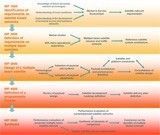
-
StatusCompleted
-
Status date2011-07-25
-
Activity Code1A.064
This project will provide a comprehensive analysis of the current situation of the ICT sector and terrestrial networks in Africa, an assessment of the technical and financial benefits that a multiple spot beam like satellite infrastructure could bring, including satellite system detailed design and programmatic aspects.
It will identify for which purpose and under which conditions, modern multibeam satellite networks can be extended to African countries.
This study will identify the requirements on satellite telecommunication networks in African developing countries in response to anticipated needs for telecommunication services. This analysis will be carried out with the support of African actors with demonstrated expertise and experience in terrestrial telecommunication networks in Africa.
The offer of satellite telecommunication networks in these countries will be characterized within the targeted 2017 timeframe. The study will elaborate a system architecture to define the requirements at satellite level, assuming the use of existing solutions for air interface, user terminals and ground infrastructure.
A satellite technical solution based on multi-beam antennas and meeting the identified requirements will be proposed, together with a programmatic approach for the satellite payload technology development and the delivery of such a solution.
The final objective of the study is to identify the technical and financial benefits, as well as the specifics of the proposed solution, for introducing multi beam satellite networks in the African developing countries. In order to achieve these objectives, the following market scenarios will be addressed:
- Backhauling of wireless terrestrial networks for two way unicast, as well as one way broadcast;
- Remote communication for in land or coastal and for fixed or mobile platforms;
- Remote communication for European governmental organisations and for fixed or mobile platforms.
The project proposes key competences, expertise and complementarities of the partners in the consortium, covering the Satcom Value Chain, as well as key African partner, considered essential to complete the study objectives on the relevance of the introduction of multiple beam satellite based networks in Africa.
The study will rely on a series of interviews with major actors and stakeholders of the African telecom market, in order to define the conditions for a successful implementation of multiple beam satellite network in Africa, together with a detailed design of the satellite system and related programmatic aspects for development, manufacturing, integration, validation, launch and in-orbit acceptance of such a satellite.
New satellite technologies like multiple beam based satellite networks are expected to drive towards a significant reduction of the cost of satellite unit bandwidth, for the delivery of broadband satellite services at attractive prices.
The main expected benefit of this project is to understand how the deployment of such satellite networks solutions may be supported, in particular by African organisations, in order to provide broadband satellite services with reduced costs.
Based on the specific user and service requirements to be collected during the first step of the study, a realistic mission scenario based on multiple beam satellite will be defined over the African continent. For each service, a set of traffic demand options will drive the definition of the system requirements in terms of capacity and flexibility over the coverage area to end up in reference system architecture for the multiple beam satellite system.
The main desirable system features can be synthesized as being the following ones:
- Minimum cost per bit for point to point applications,
- Flexible geographical allocation of resources,
- Seamless usage experience across coverage,
- Reliable capacity availability,
- Compatibility with existing equipments, networks and business,
- Possibility to go to the next-generation equipment, network, business.
Typical Multiple beam satellite network architecture
The project is scheduled to last 12 months. The activity is organised in 5 main tasks:
- Identification of requirements on satellite based networks,
- Definition of requirements on multiple beam networks,
- Design of a multiple beam satellite,
- Definition of a programmatic dossier,
- Performance evaluation and synthesis.
The 5 phases of the project take places sequentially.







